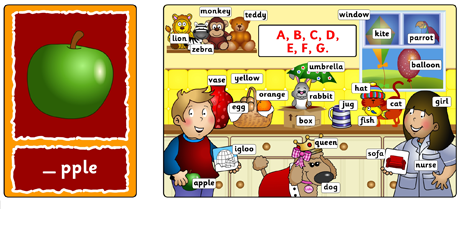Articles for Teachers
by Naomi Simmons
Most modern English courses for children include phonics lessons. This can be very confusing if you learned English a different way. In the past, most people learned their English letters by learning each letter’s name. These letter names are what you say when you say the alphabet, ABC etc. The phonics approach teaches children the letter sounds, so they learn to make the sound “l” when they see the letter L, rather than the letter name L (pronounced El).
Most courses teach the letter names too when they learn to recite the alphabet, but the focus of a phonics method is learning the letter sounds.
What is phonics?
Phonics (also called Sounds and Letters), teaches the relationship between letter combinations and the sounds they make. Although there are 26 letters in the English alphabet, there are at least 55 sounds. Most are written by combining letters in different ways.
Why do we teach it?
Phonics is used in schools throughout the English speaking world to help children learn to read and spell quickly. By learning the relationship between letters and sounds, the children are able to use these skills to work out how to read and pronounce the words they see. It also helps them to guess how to spell most words. This greatly increases the speed of learning. The focus on identifying sounds also helps English learners with pronunciation and listening skills.
How is it taught?
In the first year of English study, the children learn the letter sounds by seeing them at the beginning of simple words, for example, d – dog, c – cat. This way they can hear the sound both on its own and at the beginning of a word.
This then moves on to learning about vowels in words: a, e, i, o, u. They learn to spell and read words by recognising and using the correct vowel.
As they progress through their English study, they learn about how letter combinations affect the sounds they make, for example, s + h makes the sound sh, as in the word shop.
They also learn to form long vowel sounds by combining letters, for example, bike, feet, etc and how to read, write and pronounce consonant blends such as bl, cr, dr, etc.
What about words that don’t follow these rules?
Not all words in English follow the phonics rules. This is one of the reasons why English is considered to be a difficult language to learn. For example, the word what is pronounced wot, For this reason, as well as learning phonics, children also need to learn how to read and spell common words that do not fit the phonics rules by memorising the letters without sounding them out. This is called the ‘Look and Say’ method. Most modern courses use this method when introducing new vocabulary and to avoid confusion, this is usually kept separate from the phonics lessons.
How does teachkidsenglish.com teach phonics? and How can I help my child learn English sounds and letters?
In teachkidsenglish.com, the children first learn new English words with the Look and Say method, so that they can read, write and spell them, even if they have not yet learned the phonics skills to do so or if the words do not follow the phonics rules. Then, in every unit, there are special phonics lessons where they learn English letter sounds and their relationship to words. In teachkidsenglish.com, we also teach the letter names so that the children can recite the alphabet and sing the alphabet song. There are many games and activities to help your child learn English sounds and letters. The next article will give you some tips and ideas of activities to do at home with your children. Look out for it in two weeks’ time.














